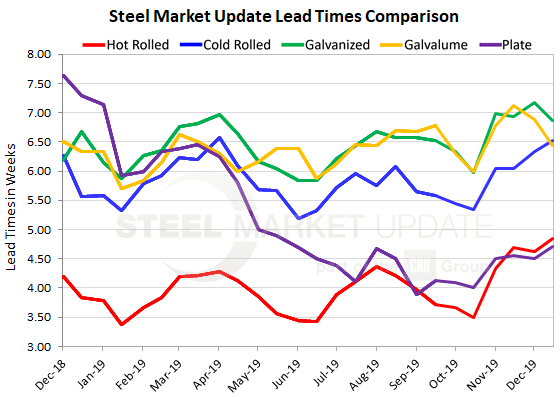SMU Data and Models

Steel Mill Lead Times: Inch Out Further
Written by Tim Triplett
December 19, 2019
After a brief hesitation early in the month, mill lead times for spot orders of flat rolled steel have continued to increase. The latest data shows slightly longer lead times for all flat rolled products except for Galvalume. Plate lead times have extended, as well. Lead times for steel delivery are a measure of demand at the mill level. The longer the lead time, the busier the mill.
The average lead time for hot rolled steel is now nearly five weeks, cold rolled is six and a half weeks and coated steels are less than seven weeks. Plate lead times are at more than four and a half weeks, according to data gathered by Steel Market Update this week.
Reporting the change in average lead times since early December, hot rolled is now at 4.84 weeks, up from 4.63 weeks. Cold rolled is up to 6.52 from 6.33 weeks.
Coated steel saw small declines in average lead times. Galvanized is now at 6.86 weeks, down from 7.18 early in the month. Galvalume dipped to 6.43 from 6.89 weeks. Lead times for spot orders of plate steel are up to 4.71 weeks from 4.50 weeks in early December. Except for plate, which is nearly three weeks shorter, lead times for all steel products are still longer than they were at this time last year.
So far, the mills have announced four rounds of price increases on flat rolled and three on plate since late October, pulling some buyers into the market ahead of the rising prices and pushing out lead times. The current hot rolled price of $570 per ton is up approximately $100 in the past two months.

Note: These lead times are based on the average from manufacturers and steel service centers who participated in this week’s SMU market trends analysis. Our lead times do not predict what any individual may get from any specific mill supplier. Look to your mill rep for actual lead times. Our lead times are meant only to identify trends and changes in the marketplace. To see an interactive history of our Steel Mill Lead Times data, visit our website here.

Tim Triplett
Read more from Tim TriplettLatest in SMU Data and Models

SMU Scrap Survey: Current, Future Sentiment Indices log declines
However, in a month plagued by tariff and economic uncertainty, both current and near-term outlooks for our scrap survey respondents remained surprisingly optimistic.

SMU’s April at a glance
SMU’s Monthly Review provides a summary of our key steel market metrics for the previous month, with the latest data updated through April 30.

SMU Survey: Steel Buyers’ Sentiment Indices see modest recovery
SMU’s Buyers’ Sentiment Indices both improved this week, reversing the decline seen two weeks ago.

SMU Survey: Sheet and plate lead times flatten out
Sheet and plate lead times held steady this week, according to buyers responding to the latest SMU market survey. This week we saw little change from mid-April levels, with just one product (Galvalume) showing any significant movement.

SMU Survey: More mills willing to deal on sheet prices, less so on plate
Nearly two thirds of the steel buyers who responded to this week’s SMU survey say domestic mills are negotiable on spot prices. This increasing flexibility marks a significant shift from the firmer stance mills held in recent months.
